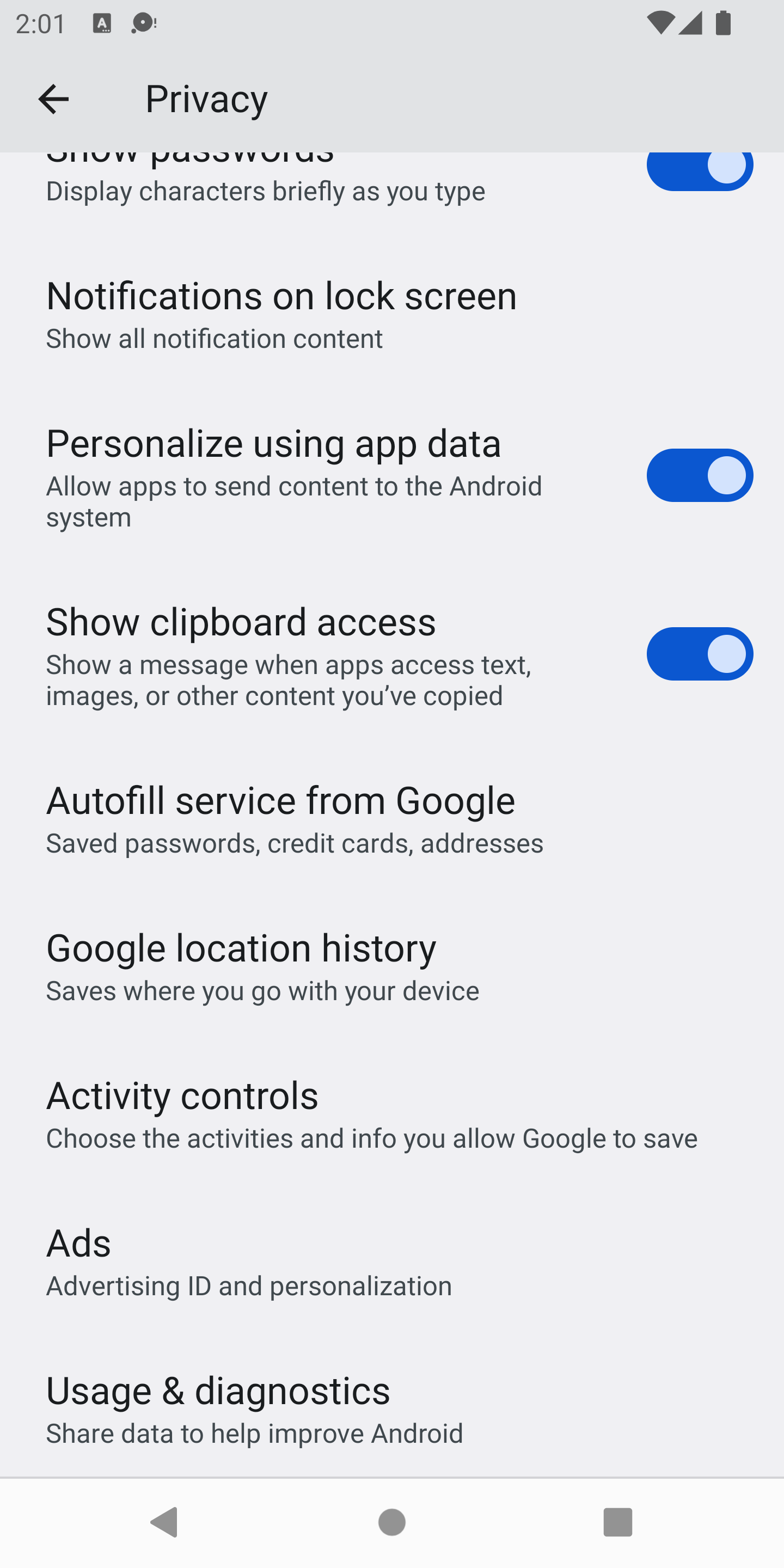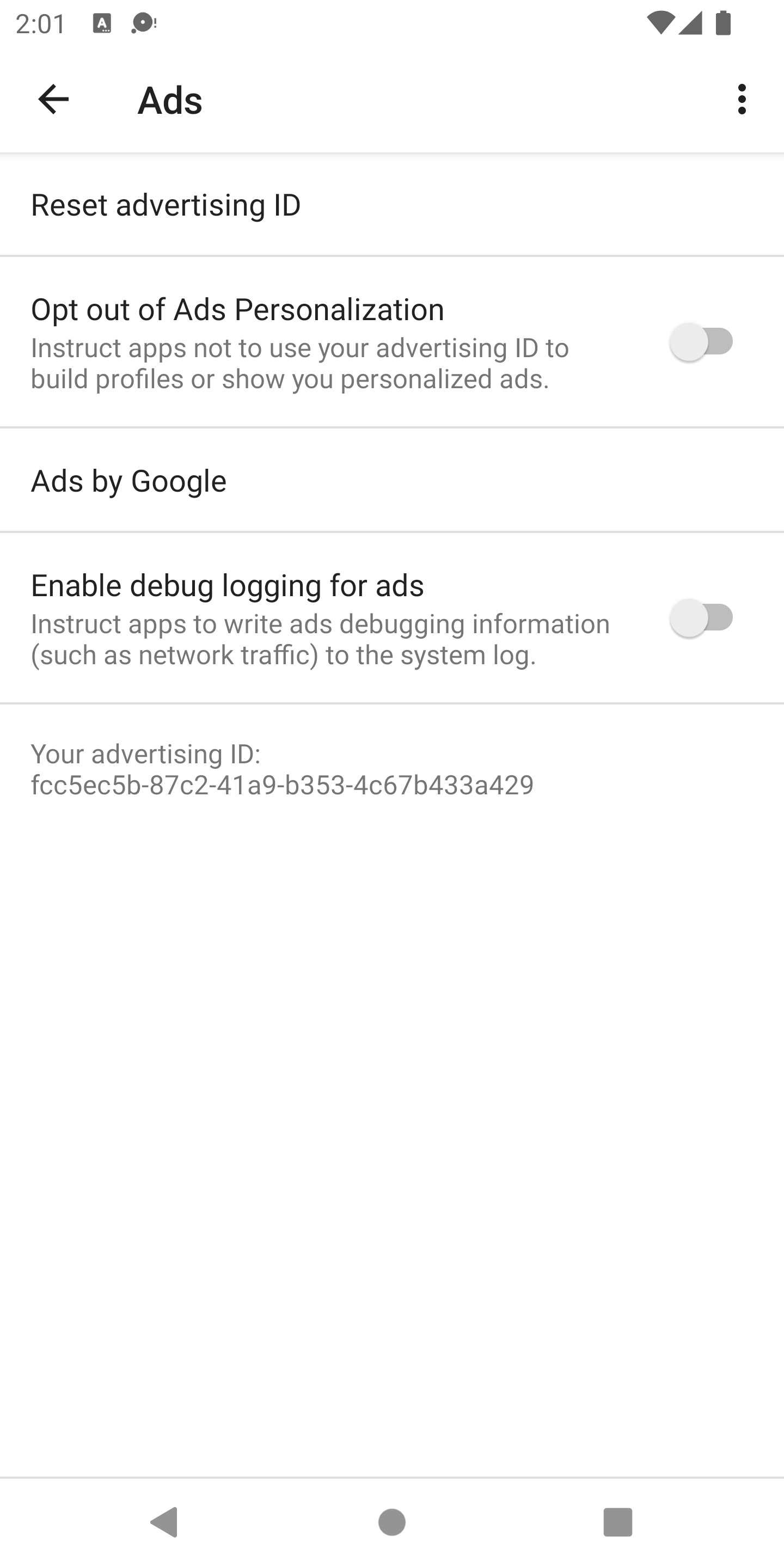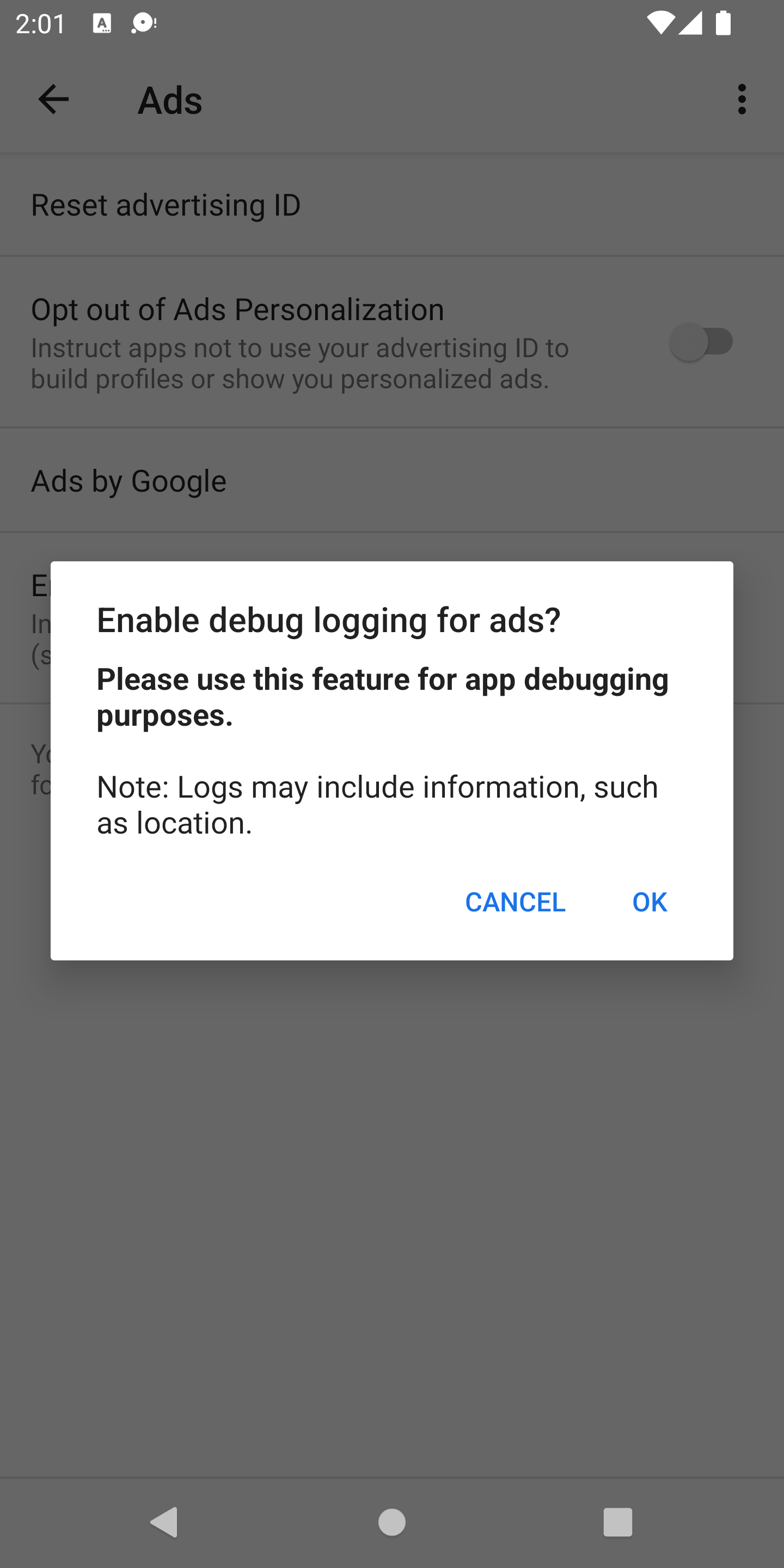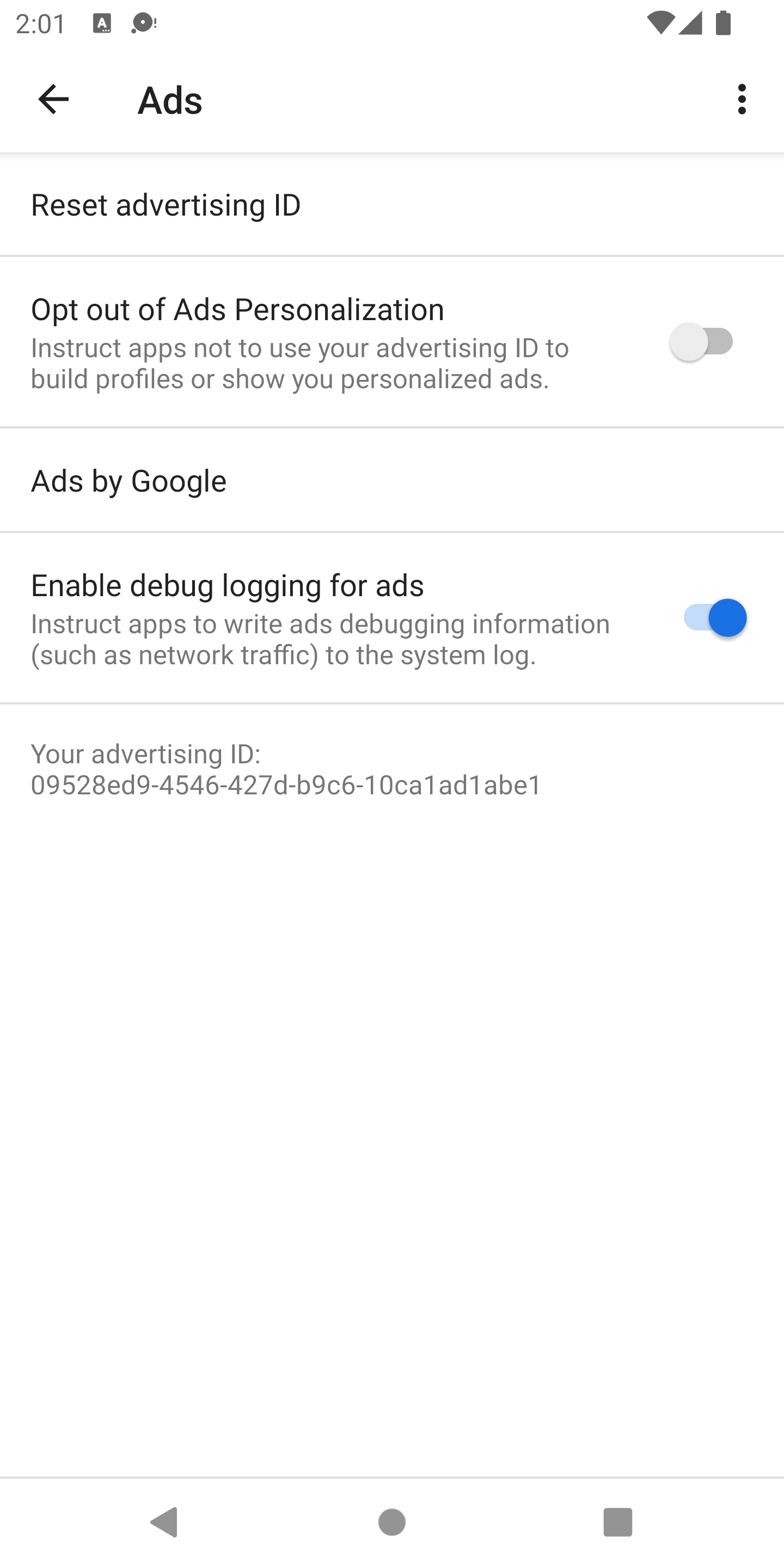Tính năng theo dõi mạng cho phép bạn xem các hoạt động mạng liên quan đến SDK quảng cáo trên thiết bị di động của Google. Tính năng này có thể hữu ích trong việc gỡ lỗi cho hoạt động triển khai Quảng cáo trên thiết bị di động của Google.
Một lý do quan trọng để sử dụng tính năng theo dõi mạng thay vì các công cụ như Proxy Charles là vì tính năng này hoạt động với tất cả các phiên bản Android và thiết bị đang chạy một phiên bản được hỗ trợ của các dịch vụ của Google Play. Tuy nhiên, tính năng này không áp dụng cho các công cụ proxy do những thay đổi về các Cơ quan cấp chứng chỉ đáng tin cậy và chứng chỉ đang được sử dụng cho Android 7.0 trở lên.
Hướng dẫn này giải thích cách bật tính năng theo dõi mạng cho mục đích gỡ lỗi.
Bật tính năng theo dõi
Để bật tính năng theo dõi mạng, hãy bật các tuỳ chọn cho nhà phát triển trên thiết bị của bạn. Sau đó, chạy ứng dụng Cài đặt Google rồi chọn mục Quảng cáo:

Giả sử bạn đã bật các tuỳ chọn cho nhà phát triển và đã có thể sử dụng tính năng này, màn hình của bạn sẽ hiển thị như sau:

Chọn tuỳ chọn Bật tính năng ghi nhật ký gỡ lỗi cho quảng cáo để mở hộp thoại sau:

Nhấn vào OK, sau đó bạn sẽ thấy một giá trị nhận dạng quảng cáo kết thúc bằng 10ca1ad1abe1:

Giờ đây, bạn có thể xem tất cả thông tin xuất từ việc ghi nhật ký mạng trong logcat. Để chỉ lọc đầu ra Quảng cáo ở cấp Thông tin cho cả màn hình và tệp, hãy đưa ra lệnh sau:
adb logcat '*:S' Ads:I Ads-cont:I | tee logs.txtĐầu ra
Các bản nhật ký trong bảng điều khiển phù hợp với nền tảng chuẩn được dùng để xuất nhật ký mạng.
Thông báo nhật ký trong bảng điều khiển luôn bắt đầu bằng chuỗi GMA Debug BEGIN, GMA Debug CONTENT hoặc GMA Debug FINISH, do đó, bạn có thể tìm kiếm hoặc lọc ra các chuỗi này. Đối với mỗi nhật ký mạng, thông điệp nhật ký đầu tiên là GMA Debug BEGIN, thông điệp nhật ký cuối cùng là GMA Debug FINISH và nội dung nhật ký mạng bắt đầu bằng GMA Debug CONTENT. Nếu nội dung không hiển thị hết trên một dòng do quá dài, nội dung sẽ được chia thành nhiều dòng, mỗi dòng bắt đầu bằng GMA Debug CONTENT.
Ví dụ về thông tin xuất trong bảng điều khiển
I/Ads ( 4660): GMA Debug BEGIN
I/Ads ( 4660): GMA Debug CONTENT {"timestamp":1510679993741,...}
I/Ads ( 4660): GMA Debug FINISH
Ví dụ về thông tin xuất JSON
Dưới đây là một số mẫu đầu ra JSON từ logcat:
onNetworkRequest
{
"timestamp": 1510679994904,
"event": "onNetworkRequest",
"components": [
"ad_request_cf5ab185-3c3f-4f01-9f56-33da2ae110f2",
"network_request_6553bc32-1d44-4f18-9dd0-5c183abbeb90"
],
"params": {
"firstline": {
"uri": "http://googleads.g.doubleclick.net/pagead/ads?carrier=....",
"verb": "GET"
},
"headers": [
{
"name": "User-Agent",
"value": "Mozilla/5.0 (Linux; Android 5.0.2;..."
}
]
}
}
onNetworkResponse
{
"timestamp": 1510679995295,
"event": "onNetworkResponse",
"components": [
"ad_request_cf5ab185-3c3f-4f01-9f56-33da2ae110f2",
"network_request_6553bc32-1d44-4f18-9dd0-5c183abbeb90"
],
"params": {
"firstline": {
"code": 200
},
"headers": [
{
"name": null,
"value": "HTTP/1.1 200 OK"
},
{
"name": "X-Google-DOS-Service-Trace",
"value": "main:pagead"
},
{
"name": "Content-Type",
"value": "text/html; charset=UTF-8"
},
...
]
}
}
onNetworkResponseBody
{
"timestamp": 1510679995375,
"event": "onNetworkResponseBody",
"components": [
"ad_request_cf5ab185-3c3f-4f01-9f56-33da2ae110f2",
"network_request_6553bc32-1d44-4f18-9dd0-5c183abbeb90"
],
"params": {
"bodydigest": "B2520049D02F3C70A12AD1BC0D1B58A4",
"bodylength": 122395
}
}

